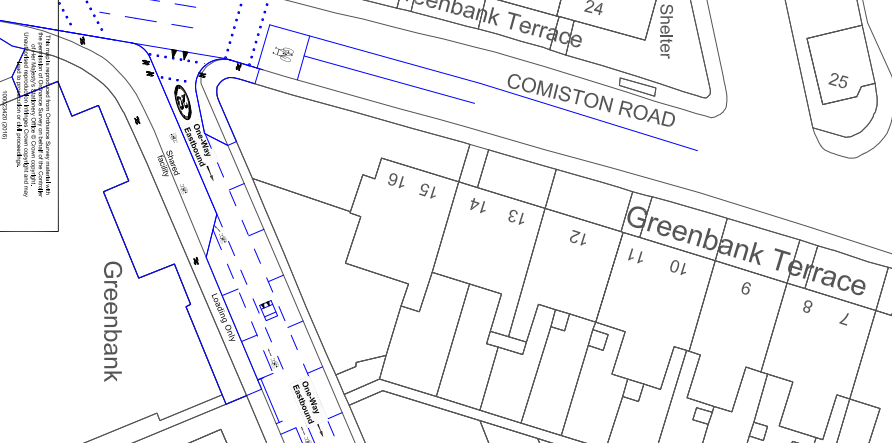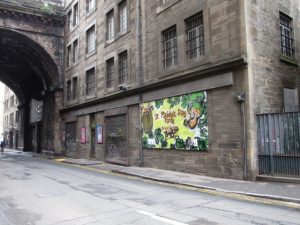LSE strongly supports and welcomes the general thrust of the City Centre Transformation proposals and is making a separate submission to that effect. With regard to this consultation, the design proposals embodied in the Concept Design for the Meadows to George St. Project are particularly welcome. The enhanced priorities for walking, cycling and public transport envisaged are essential for the improvement of the Meadows to George St. Route and for the city centre as a whole.
Traffic Reduction and Pedestrianisation
The proposals to remove general traffic from George 1V Bridge and part of the Mound, and to eliminate the outmoded Forrest Rd./Teviot Place/ Bristo Place gyratory scheme are particularly welcomed. So too is the intention to restrict access along Forrest Rd primarily to walking and cycling, with restricted loading/ unloading hours for deliveries. This would release the potential to create a vastly improved environment for pedestrians in and around Forrest Rd. The extent to which that potential is realized will depend on there being effective management and enforcement regimes in place regarding both access for deliveries and the disposal of waste. All too often such good management and enforcement have been lacking to date. We therefore would expect to see proposals for effective scheme management and enforcement advanced in parallel with the detailed designs for this scheme. We also have reservations as to whether all bus services should be removed from Forrest Rd, as discussed below.
The diversions of general traffic away from George1V Bridge via Chambers St and Market St are very welcome in principle, but it seems obvious that this will mean higher traffic levels on the Bridges and Jeffrey Street. Not all of the diverted traffic can realistically be expected to evaporate. It therefore seems reasonable to expect to see some analysis of the expected impact, especially on the Bridges route, since it is already operating under stress, with a poor accident record, being often congested, and where current conditions for pedestrians are as bad as or worse than those on George 1V Bridge. Until these impacts are clarified, we cannot unreservedly support these traffic proposals.
The Cycleway
The design concept proposals envisage a 3 metre wide, 2-way cycleway along the east side of the route, through George 1V Bridge, the Mound and Hanover St. This is preferable to the alternative of 1-way cycleways along both sides of the street, in that it allows more space for wider pavements, and reduces the conflicts between pedestrians and cyclists at bus stops, halving the number of such locations. There remain nevertheless some serious difficulties associated with the floating bus stop design, and at the east side stop at the foot of the Mound in particular.
Floating Bus Stop Provision
Our concern over floating bus stop design centres on the conflicts they introduce between cyclists and pedestrians crossing the cycle lane to board a bus, or alighting from buses into the cycle lane. It is worth noting that the recent re-introduction of rear door exit buses by Lothian Buses is almost certain to make the alighting conflicts greater. Moreover we are still awaiting the findings from the promised evaluation of the Leith Walk floating bus stop.
We are not aware of any precedents of busy two-way cycle lanes at floating bus stops, either in Edinburgh or elsewhere in the UK. The Council’s own street design guidance (Factsheet C4, Segregated Cycle Tracks) only addresses one way cycle tracks at bus stops. This design therefore does not appear to conform to Council design standards.
The proposed design for the crossing points at the floating bus stops has included some highly desirable elements that LSE would regard as essential. The two raised and zebra striped crossings of the cycleway, linking to the floating platform on either side of the stop/shelter position, are of vital importance. Sufficient width, height, and ramping will all be critical to how well they help to reduce conflicts with cycling. A standard crossing width will not be adequate given the peaked nature of crossing at bus boarding times, and we suggest that they should be of at least twice the standard width, if not more when based on current and forecast passenger pick up and drop off levels.
At the foot of the Mound, and to a lesser extent in Hanover St., cyclists would be approaching the bus stop downhill, at speed in many cases, and creating severe conflicts with pedestrians at the stop. This is unsafe. At the 3rd June workshop cycling representatives also raised concerns about the suitability of the 2-way cycleway provision over this steep downhill section, and it was suggested that downhill cyclists should use the carriageway instead. We would strongly endorse this suggestion, as it would reduce the most severe conflicts that are otherwise likely to arise.
The platforms associated with the proposed floating bus stops would provide some additional space for awaiting passengers, but at the busy stops and pavements involved there is concern that this space would still be inadequate to allow for the concentration of conflicting pedestrian movements, and for safe interactions with cyclists in particular. Moreover those concentrations are being intensified at some of the busiest stops, in Hanover St and at the bottom of the Mound, by having a single stop and a single shelter for all bus services. The loss of already inadequate shelter and seating space at these stops will inevitably mean worse conditions for waiting pedestrians, and for those with mobility impairments in particular. We can see no justification for this and wish to see these losses compensated for by the provision of additional shelter and seating. That provision should be informed by an analysis of pedestrian flows and passenger usage at peak times of the year for the stops involved. It is difficult to believe that this has been undertaken for these stops to date (if it has can we please see the results?), but it should become a routine procedure wherever a reduction in stop and/or shelter/ seating provision is under consideration.
Other Bus Services and Stops
A similar reduction in provision of bus stop facilities is seemingly proposed in shifting the provision of bus services from Forrest Rd. to Teviot Place, and gives rise to similar concerns. This shift is also likely to result in longer walks to most destinations and have adverse effects on the growing proportion more vulnerable bus users who are mobility impaired as pedestrians. We would wish to see a thorough analysis of this issue being undertaken before a commitment is made to the move. More generally this is an important issue that has not been receiving sufficient attention as yet in developing the wider City Centre Transformation proposals.
At the workshop we were informed that under the revised bus stop arrangements there would be no breaches of the CEC standard for the maximum walking distance between stops, which we understand to be 400m. It is understand that only one bus stop is to be removed under the concept design proposals, that being at the uphill stop on the Mound close to the junction with Market St. LSE does not object to this change since this stop is little used and does not serve any significant destinations. However, with no compensating changes being made to the stop locations along the route on either side, the distance to the next southbound bus stop (National Library) is about 500m. There will be pedestrians undertaking a longer and steep uphill walk, so there should be seating provided at intervals to help ease them on their way. The additional space proposed for pedestrians at the junction with Market St., and in association with the welcome closure of St Giles St. to traffic from Bank St., would seem to offer suitable locations. Such provision is especially important given the heavy demand for bus passengers and other pedestrians to visit the High Street.
Pedestrian Crossings
The loss of the median strip, which currently enhances the crossing opportunities for pedestrians throughout George 1V Bridge, is regrettable, but is seen to be acceptable given the wider pavements and reduced 6.5m carriageway width envisaged, provided that the current number of locations for crossing facilities is retained.
More formal enhanced crossings are proposed, light controlled at the Chambers St junction and with a zebra facility approximately half way along. It seems that dropped curb crossing points are envisaged at the other locations, but it is not clear from the on-line consultation drawings that this is the case, so we would appreciate clarification. There is a high demand for crossing next to the Victoria St. Junction and a clearly designated crossing facility is needed at this point in particular.
The proposed crossing of Bristo Place, Bedlam to the Museum, will provide a welcome and much needed facility.
Pavements
Wider pavements and other additional pavement space are an integral and very much needed feature of the concept proposals, and we look forward to the detailed development of these proposals.
There remain nonetheless some pavements where widths that are sub-standard remain; specifically along the Mound beside the RSA and National Galleries, and in Bristo Place. The space available at the east side Hanover St junction with Princes St also remains inadequate for the intense concentrations of pedestrians wanting to cross there.
The Mound galleries section is a particular concern. It is only ~ 2m wide, in contrast to the 3m minimum desirable width specified by the Council’s Design Guidance. This pavement serves many pedestrians, especially at peak seasons for visitors. Those numbers can only be expected to increase, and a wider pavement should clearly be provided here. It would also be running alongside the proposed 3m wide cycleway serving many fewer cyclists, unless that section is modified to allow downhill cyclists to use the carriageway. Such a modification would have the added advantage of making it easier to accommodate the widened pavement that is needed.
The Bristo Place east side pavement is only ~ 2.5m wide, and can be expected to have to accommodate substantially more pedestrians if the relocation of the Forest Rd bus stops to Teviot Place goes ahead. We would therefore wish to see a wider pavement included here in developing the detailed designs. All the more so, and essential, if a loading area is to be part of the design. From the exhibition drawings it would appear that a loading area is envisaged that overlaps with the existing pavement, and would take up most of the existing pavement width! This would be totally unacceptable for pedestrians.
It is claimed that a SUSTRANS analysis concluded that “all pavements reach the desired comfort level of the Edinburgh Street Design Guidance”. It is difficult to understand how this conclusion could have been reached in regard to these particular sections of pavement, and we can only surmise that the analysis was undertaken at an off peak time of year and with no allowance for the increases in activity that are to be expected over the years to come. We would like some clarification on this and would appreciate the analysis being made available.
Greyfriars Bobby
The numbers of worshipers arriving at the wee dug’s statue, to stand and stroke and photograph him, have long resulted in severely obstructed space for pedestrians with crowds spilling over into the carriageway much of the time. The increased space it is proposed to provide will help to alleviate the current conditions, but will not eliminate the problems. Those problems moreover can only be expected to grow as the numbers of tourists continue to increase. It is surely therefore time, in association with this project, for Bobby to be provided with a new home, away from the street and safer for all concerned. Preferably perhaps this should be in Greyfriars Kirkyard, where he can be re-united with his master and where the worship can take place in appropriate peace. Please make him party to the project too.






